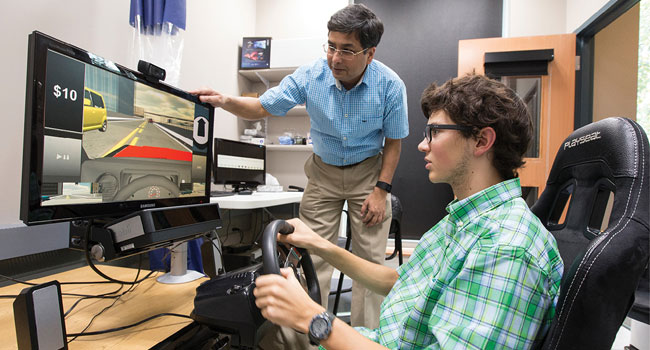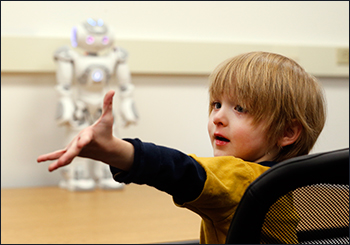
April is National Autism Awareness Month
A recent CDC announcement reports that one in 88 children have an Autism Spectrum Disorder, up from one in 110 released in 2009.
ASD refers to a range of conditions characterized by challenges with social skills, repetitive behaviors, speech and nonverbal communication, as well as by unique strengths and differences. There is not one autism but many types, caused by different combinations of genetic and environmental influences.

Researchers at Vanderbilt are working to develop technologies and therapies to help better manage the symptoms of ASD.
“In engineering, we try to solve real world problems,” said Philippe Fauchet, dean of the School of Engineering. “We develop the advanced technologies, the computer science approaches, the robotic approaches, but we want them to be useful for something. This is a clear case where there is a need: people with autism.”
One area of research is the development of assistive technologies that can support autistic individuals in the workplace, and an example of this is a simulator designed to help teenagers with ASD learn how to drive.
A number of capabilities have been built into the Vanderbilt VR Adaptive Driving Intervention Architecture. Not only is it specifically designed to teach adolescents with ASD the basic rules of the road, but VADIA also gathers information about the unique ways that they react to driving situations. This will allow the system to alter driving scenarios with varying degrees of difficulty to provide users with the training they need while keeping them engaged in the process. Ultimately, it may also help screen individuals whose deficits are too severe to drive safely.

“A number of high functioning individuals with ASD do drive and studies have shown that when they are learning they tend to make certain kinds of mistakes more often than other beginning drivers. So how you train them is very important,” said Nilanjan Sarkar, professor of mechanical engineering and director of the Robotics and Autonomous Systems Lab. He heads up the project, which is described in detail in an article published online in the Transactions on Interactive Intelligent Systems.
Sarkar continues to build on earlier research using humanoid robots to help train children with autism. Russell, a two-foot tall humanoid robot, acts as the front man for ARIA, an elaborate system of cameras, sensors and computers developed at Vanderbilt that helps young children diagnosed with autism spectrum disorder (ASD) learn basic social skills.
Experiments show children with ASD pay more attention to the robot than they do to human therapists and accurately follow its instructions during sessions designed to teach critical communication skills.
Early data from the NSF-funded research suggest that engaging with Russell, programmed with sophisticated capabilities to continuously track and automatically adapt to children’s behaviors in real-time, both captures children’s attention and improves skills critical to intervening early after an ASD diagnosis.

One of the current objectives of the Artificial Intelligence and Visual Analogical Systems Lab is to better understand how visual thinking works in the human brain for neuro-typical and neuro-diverse individuals. To better understand this, AIVAS lab director and computer science assistant professor Maithilee Kunda, often asks, “close your eyes. Now, how many windows are in your house? It is likely that you used visual thinking to come up with your answer.”
Several research projects in the lab involve recording human test participants as they solve puzzles that use visual and spatial cues, analyzing how these participants go about solving each puzzle, then configuring cognitive AI systems to emulate these problem-solving strategies.
One potential discovery that could impact the work of the Initiative for Autism Innovation and the Workplace is identifying measurable differences in how neuro-typical versus neuro-diverse subjects solve complex problems. This could help in identifying talents such as superior visuospatial reasoning, useful for specific applications in industry such as inspecting goods or equipment for subtle differences that could be the product of a defect.
Below are examples of the work being done in the School of Engineering:
VADIA: VR Adaptive Driving Intervention Architecture
Collaborators at Vanderbilt’s School of Engineering and the Kennedy Center have created a simulator that is meant to teach ASD teenagers critical driving skills.
RASL: Robotics and Autonomous Systems Lab at Vanderbilt
A lab dedicated to developing new generations of robots and computer-based intelligent systems that are able to interact with people in a smooth and natural way.
Vanderbilt Initiative for Autism, Innovation, and the Workforce
The purpose of the initiative is to advance workforce innovation through the employment of autistic adults, with the Nashville Model as our testbed.
Artificial Intelligence and Visual Analogical Systems Lab
This lab uses cognitive systems approaches from artificial intelligence (AI) to better understand how visual thinking works in the human brain for neuro-typical and neuro-diverse individuals.
Contact: Brenda Ellis, (615) 343-6314
brenda.ellis@vanderbilt.edu